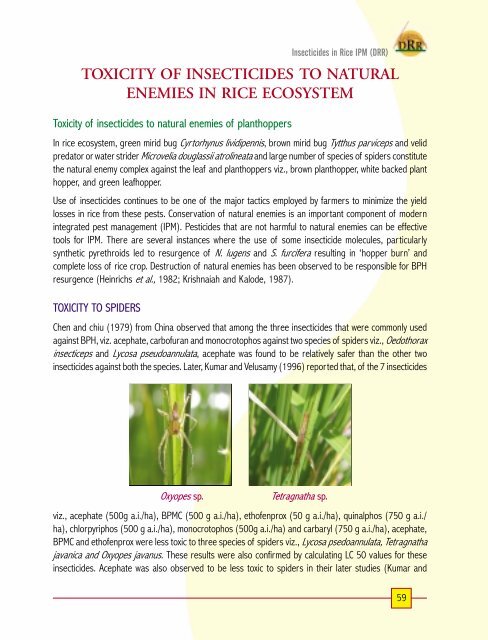priciples of insecticide use in rice ipm
priciples of insecticide use in rice ipm
priciples of insecticide use in rice ipm
Create successful ePaper yourself
Turn your PDF publications into a flip-book with our unique Google optimized e-Paper software.
Insecticides <strong>in</strong> Rice IPM (DRR)<br />
TOXICITY OF INSECTICIDES TO NATURAL<br />
ENEMIES IN RICE ECOSYSTEM<br />
Toxicity <strong>of</strong> <strong><strong>in</strong>secticide</strong>s to natural enemies <strong>of</strong> planthoppers<br />
In <strong>rice</strong> ecosystem, green mirid bug Cyrtorhynus lividipennis, brown mirid bug Tytthus parviceps and velid<br />
predator or water strider Microvelia douglassii atrol<strong>in</strong>eata and large number <strong>of</strong> species <strong>of</strong> spiders constitute<br />
the natural enemy complex aga<strong>in</strong>st the leaf and planthoppers viz., brown planthopper, white backed plant<br />
hopper, and green leafhopper.<br />
Use <strong>of</strong> <strong><strong>in</strong>secticide</strong>s cont<strong>in</strong>ues to be one <strong>of</strong> the major tactics employed by farmers to m<strong>in</strong>imize the yield<br />
losses <strong>in</strong> <strong>rice</strong> from these pests. Conservation <strong>of</strong> natural enemies is an important component <strong>of</strong> modern<br />
<strong>in</strong>tegrated pest management (IPM). Pesticides that are not harmful to natural enemies can be effective<br />
tools for IPM. There are several <strong>in</strong>stances where the <strong>use</strong> <strong>of</strong> some <strong><strong>in</strong>secticide</strong> molecules, particularly<br />
synthetic pyrethroids led to resurgence <strong>of</strong> N. lugens and S. furcifera result<strong>in</strong>g <strong>in</strong> ‘hopper burn’ and<br />
complete loss <strong>of</strong> <strong>rice</strong> crop. Destruction <strong>of</strong> natural enemies has been observed to be responsible for BPH<br />
resurgence (He<strong>in</strong>richs et al., 1982; Krishnaiah and Kalode, 1987).<br />
TOXICITY TO SPIDERS<br />
Chen and chiu (1979) from Ch<strong>in</strong>a observed that among the three <strong><strong>in</strong>secticide</strong>s that were commonly <strong>use</strong>d<br />
aga<strong>in</strong>st BPH, viz. acephate, carb<strong>of</strong>uran and monocrotophos aga<strong>in</strong>st two species <strong>of</strong> spiders viz., Oedothorax<br />
<strong>in</strong>secticeps and Lycosa pseudoannulata, acephate was found to be relatively safer than the other two<br />
<strong><strong>in</strong>secticide</strong>s aga<strong>in</strong>st both the species. Later, Kumar and Velusamy (1996) reported that, <strong>of</strong> the 7 <strong><strong>in</strong>secticide</strong>s<br />
Oxyopes sp. Tetragnatha sp.<br />
viz., acephate (500g a.i./ha), BPMC (500 g a.i./ha), eth<strong>of</strong>enprox (50 g a.i./ha), qu<strong>in</strong>alphos (750 g a.i./<br />
ha), chlorpyriphos (500 g a.i./ha), monocrotophos (500g a.i./ha) and carbaryl (750 g a.i./ha), acephate,<br />
BPMC and eth<strong>of</strong>enprox were less toxic to three species <strong>of</strong> spiders viz., Lycosa psedoannulata, Tetragnatha<br />
javanica and Oxyopes javanus. These results were also confirmed by calculat<strong>in</strong>g LC 50 values for these<br />
<strong><strong>in</strong>secticide</strong>s. Acephate was also observed to be less toxic to spiders <strong>in</strong> their later studies (Kumar and<br />
59











